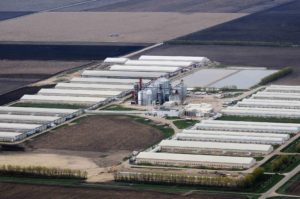More than 10 million Iowa birds, mostly commercial layer hens, have been or soon will be culled in an effort to combat the spread of H5N2, an avian flu virus. And, as I was writing this, an additional 5.6 million layer hens and a yet unknown number of commercial turkeys were tagged by the Iowa Department of Agriculture as probably infected with the bird flu virus.
Given Iowa’s role in egg production — one out of every five eggs consumed in the U.S. comes from Iowa — and the wide swathes of the state economy dependent on agriculture, the situation is clearly cause for the state to issue a disaster declaration. Yet. Gov. Terry Branstad has declined.
(Update May 1, 3:15 p.m. — With the number of confirmed and probable sites of contamination increasing to 21, Gov. Terry Branstad declared a state of emergency in Iowa. “While the avian influenza outbreak does not pose a risk to humans, we are taking the matter very seriously and believe declaring a state of emergency is the best way to make all resources available,” Branstad said. The outbreak now spans 10 Iowa counties — Buena Vista, Cherokee, Clay, Kossuth, Madison, O’Brien, Osceola, Pocahontas, Sac and Sioux.)

Jimmy Centers, Branstad’s spokesman, said the governor would consider a declaration, but no requests have been made. He added that a declaration is not needed for the state to coordinate resources to combat the outbreak.
Several state agencies — the departments of Natural Resources, Public Health, Human Services and Inspections and Appeals — are working with Homeland Security to respond to and monitor areas of contamination.
Governors in Wisconsin and Minnesota have made disaster declarations and called the National Guard to help contain and respond to bird flu outbreaks.
The H5N2 bird flu strain can decimate entire flocks of poultry within 48 hours, forcing disposal of mass remains and disinfection of poultry houses and other equipment. While the virus is believed to have traveled to the Midwest with wild waterfowl, no one can yet explain how it has entered poultry houses. Since it is possible the virus could have entered the buildings through ventilation or on workers’ shoes or other clothing, most producers have cracked down on biohazards.
Experts are watching to see if the virus will mutate and jump to people, and have offered precautionary anti-viral drugs to those working directly with infected birds. Since no people have been infected, scientists are cautiously optimistic the strain cannot easily attach to human cells.
Even with a potential health care crisis abated, economic losses are already underway.
The U.S. Department of Agriculture’s Animal and Plant Health Inspection Service has increased field workers. An APHIS official also said the department has pooled nearly $85 million in response funds, but roughly $60 million in indemnity claims by poultry farmers are already expected.
On average, Iowa farms house about 60 million laying hens. About a sixth of the state’s population has now fallen to the virus as have additional hens and turkeys in several states. Iowans who maintain backyard flocks or who run other poultry operations are taking additional precautions against the virus. Those located near contaminated and quarantined facilities are undergoing testing.
Reductions could impact consumer prices, but current economic concerns are focused on international response. Mexico, for example, has stopped Iowa egg imports.
Iowa’s and the nation’s egg producers suffered under a massive 2010 salmonella outbreak originating in our state. Inspection and other reforms aimed at preventing similar scenarios and advancing the industry’s reputation were set aside by the Branstad administration.
Fate has once again negatively touched Iowa’s egg producers and poultry farmers. These individuals as well as their employees and communities will need the state’s helping hand to overcome. A disaster declaration is a show of solidarity that moves the process forward.
This column by Lynda Waddington originally published in The Gazette on May 1, 2015. Photo credit: Joe Ahlquist/Reuters
